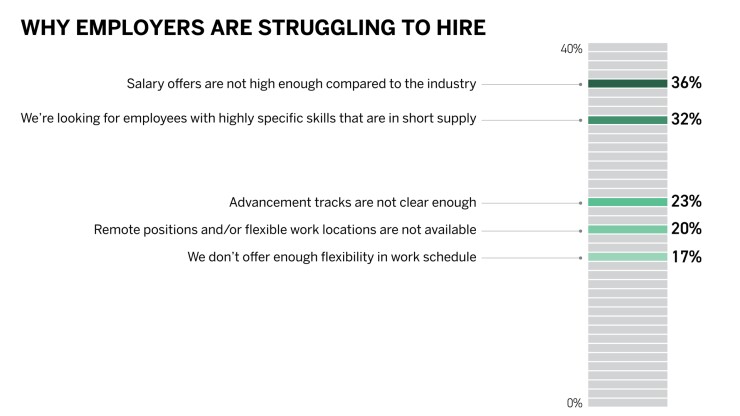For weary HR leaders and business managers, who have already had to guide their teams through the relentless
Where should employers start? By listening to the employees who are leaving, offering support to those who stay, and following COVID-borne trends —
From
Read more:
The following study and
Why are employees quitting? Opinions vary
There seems to be no clear-cut answer for why so many employees are heading for the door. Yet across industries, low compensation seemed to be the culprit, with 18% saying this was the

Employers have also noticed a variation in who is leaving the workforce, pointing to the unique stressors many employees have faced during this time.
Read more:
In order to address these issues, employers must boost their support for working parents and other staff. And while addressing compensation may be one way to bridge the gap, it’s not always possible for employers to do so. However, the survey found that many of the reasons go beyond just a number on a pay stub: from a lack of advancement opportunities, to cultural challenges and issues with management, it seems employees are eager for new professional priorities that more closely align with the values they’re prioritizing post-COVID.
Why can’t we hire? The great debate among HR leaders
Ninety percent of employers admit to recruiting challenges, and once more, no one reason is clear. While

It’s time to embrace remote work, once and for all
Research from Slack’s Future Forum found that 95% of employees want
Several leaders shared their perspective on the impact their in-office policies are having on their retention and attraction strategies:
• “Our jobs do not offer flexible office locations compared to the same industry, making it difficult to recruit skilled employees. We are ready to increase the flexibility of our office location.”
• “I would allow 100% remote work for any position that could be conducted in such a manner. Right now we are forcing hybrid or fully in-office on our employees, and that just isn’t going to work anymore. Companies that do not adapt to the new remote mentality will continually suffer higher than normal attrition rates as we lose employees to companies that allow for 100% remote work.”
• “Now that COVID is less of a concern, our employer is forcing people (even former remote employees) to come into an office location, even if it means relocating. This is a poor choice from senior leadership and is causing highly knowledgeable, quality talent to leave.”
What else can be done? A look at the benefits changing the game
Throughout the pandemic, organizations have focused on benefits that improve
Read more:
As employees continue to look toward their employer for support, the relationship between the two has changed forever. Employers must stay ahead of the game and continue to offer competitive benefit offerings that go beyond basic health and wellness plans.
Managers and HR leaders must communicate and agree on the best way forward. Only in this collaboration can businesses move forward with a clear strategy for the challenges ahead — and provide a bright future for their employees and their businesses.






